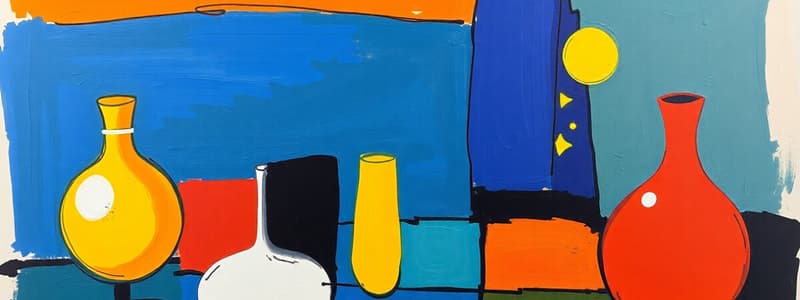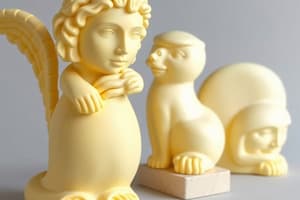Podcast
Questions and Answers
What are the primary characteristics of architecture?
What are the primary characteristics of architecture?
- It primarily exists in the form of paintings.
- It is always temporary in nature.
- It is highly spatial, functional, and associated with technology. (correct)
- It focuses on aesthetics and decoration.
Which materials can decorative objects be made from?
Which materials can decorative objects be made from?
- Digital formats only.
- Glass and plastic exclusively.
- Only paper and textiles.
- Wood, ceramics, and metal among others. (correct)
What defines ephemeral arts?
What defines ephemeral arts?
- They are always displayed in permanent galleries.
- They are never meant to be interactive.
- They exist only for a finite time or must be replayed to be experienced. (correct)
- They are created using traditional materials only.
What information is typically included in the caption of a work of art?
What information is typically included in the caption of a work of art?
Which of the following statements about photographic images is accurate?
Which of the following statements about photographic images is accurate?
Which of the following is NOT a visual characteristic of art?
Which of the following is NOT a visual characteristic of art?
What does the term 'context' in art history primarily refer to?
What does the term 'context' in art history primarily refer to?
Which component of art history addresses what is being communicated through the artwork?
Which component of art history addresses what is being communicated through the artwork?
Which of the following questions helps discover the context of an art object?
Which of the following questions helps discover the context of an art object?
What are the dimensions of an art object classified as?
What are the dimensions of an art object classified as?
Which of the following pairs correctly categorizes the three primary aspects of art history?
Which of the following pairs correctly categorizes the three primary aspects of art history?
What does 'form' in art history refer to?
What does 'form' in art history refer to?
Which element does NOT fall under the visual characteristics of art?
Which element does NOT fall under the visual characteristics of art?
What does the term 'medium' refer to in the context of art?
What does the term 'medium' refer to in the context of art?
Which of the following is NOT a form of painting?
Which of the following is NOT a form of painting?
What distinguishes free-standing sculpture from relief sculpture?
What distinguishes free-standing sculpture from relief sculpture?
Which statement about graphic arts is true?
Which statement about graphic arts is true?
How can photographs be described in terms of their medium?
How can photographs be described in terms of their medium?
What is a characteristic of relief sculpture?
What is a characteristic of relief sculpture?
What period does the ARTH 100 course typically cover in art history?
What period does the ARTH 100 course typically cover in art history?
In the study of art, which of the following represents a two-dimensional art form?
In the study of art, which of the following represents a two-dimensional art form?
What does the term 'form' refer to in the study of art history?
What does the term 'form' refer to in the study of art history?
Which element is NOT a component of art history as defined in the course?
Which element is NOT a component of art history as defined in the course?
Why is taking great notes emphasized in the course?
Why is taking great notes emphasized in the course?
How is 'content' defined in the context of art history?
How is 'content' defined in the context of art history?
Which aspect is NOT considered when analyzing the context of an art object?
Which aspect is NOT considered when analyzing the context of an art object?
What are the three main aspects studied in art history to understand an art object's function?
What are the three main aspects studied in art history to understand an art object's function?
What is the physical characteristic of the 'Woman from Willendorf' sculpture?
What is the physical characteristic of the 'Woman from Willendorf' sculpture?
Which painting was created by Alice Neel in 1980?
Which painting was created by Alice Neel in 1980?
What characteristic best describes the 'Woman from Willendorf' in terms of its art historical significance?
What characteristic best describes the 'Woman from Willendorf' in terms of its art historical significance?
What is the primary objective of understanding an art object's context?
What is the primary objective of understanding an art object's context?
Flashcards are hidden until you start studying
Study Notes
Introducing ARTH 100
- Art History is the study of an art object's form, content, and context.
- Form is an art object's physical and visual characteristics.
- Content refers to what is being communicated by the art object, such as the subject matter or theme.
- Context refers to the historical circumstances (time, place, political, social, religious, intellectual cultures) in which an art object was made and viewed.
Learning the Language of Art
- Medium is the type of art object, often including the material it's made from.
- Painting is a two-dimensional representation made with pigment.
- Sculpture is a three-dimensional representation, often made of wood, stone, bronze, ivory, or marble.
- Free-standing sculptures are surrounded by space.
- Relief sculptures project from a flat background.
- Graphic Arts include drawings and prints.
- Drawings are made by hand.
- Prints are made using machines.
- Photography involves creating optical images on light-sensitive surfaces, typically using a camera.
- Decorative Objects are made from materials such as ceramics, metal, and wood.
- Architecture creates enclosures for human activity, and is closely tied to technology and materials.
- Ephemeral Arts include processions, ceremonies, performance art, earthworks, cinema, and video art.
ARTH 100 Course
- ARTH 100 covers art from prehistory (30,000 BCE) to the present (stopping typically in the 19th century).
Understanding Captions
- Captions typically include the artist, title, year made, medium, material, and dimensions of an art object.
Compare and Contrast
- Woman from Willendorf is a sculpture, created in limestone, circa 24,000 BCE.
- Self Portrait is a painting in oil on canvas, created in 1980 by Alice Neel.
Studying That Suits You
Use AI to generate personalized quizzes and flashcards to suit your learning preferences.




